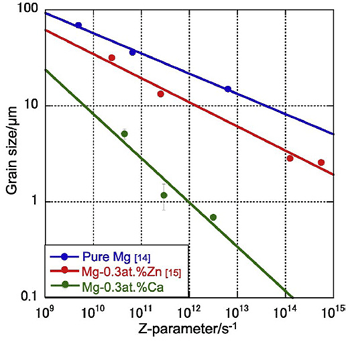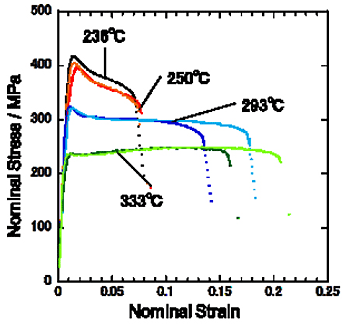Mg–0.3 at.% Ca solid solution alloy is a strong candidate for biodegradable bone fixation devices with high biocompatibility. Since they must support bone tissue for 16 weeks, required initial yield stress is estimated to be 400 MPa. In this study, Hall–Petch relationship and the relationship between the Zener–Hollomon parameter (Z parameter) and dynamically recrystallized grain size (DRX) was investigated to fabricate Mg–Ca alloy with tensile yield strength over 400 MPa.
Figure 1 Relationship between the recrystallized grain size and the Zener–Hollomon parameter for Mg–0.3 at.% extruded at various temperatures and extrusion ratio of 25:1. The grain diameter calculated from these images become smaller at lower extrusion temperatures as expected. When compared the relationship between Z parameter and DRX of the Mg–Ca alloy with those of Mg-Zn alloy and pure magnesium, the grain size of Mg–Ca become smaller than those of Mg–Zn and pure Mg under the same dynamic recrystallization conditions. These results imply that the addition of calcium which decreases stacking fault energy has a strong impact on grain refinement. The grain refinement contributed to better tensile yield stress as shown in Fig. 2.
Hall-Petch relationship and relationship between Z parameter and DRX obtained from these results pointed out the average grain size and appropriate extrusion condition to attain the target strength (400 MPa). Therefore, the extrusion of the Mg–0.3 at.% Ca alloy at 236 °C was conducted. The grain size of newly developed Mg–Ca alloy is 0.5 µm. As a result, the Mg–0.3 at.% Ca alloy exhibited a high tensile yield strength in excess of 400 MPa.

